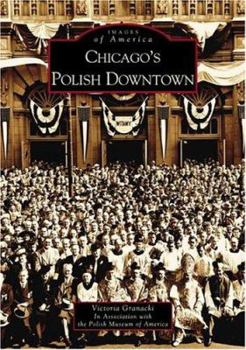Chicago's Polish Downtown
(Part of the Images of America: Illinois Series)
Select Format
Select Condition 
Book Overview
Illustrating the first 75 years of Chicago's influential Polish neighborhood. Polish Downtown is Chicago's oldest Polish settlement and was the capital of American Polonia from the 1870s through the... This description may be from another edition of this product.
Format:Paperback
Language:English
ISBN:073853286X
ISBN13:9780738532868
Release Date:July 2004
Publisher:Arcadia Publishing (SC)
Length:128 Pages
Weight:0.70 lbs.
Dimensions:0.4" x 6.5" x 9.4"
Customer Reviews
1 rating
SIZE DOESN'T ALWAYS MATTER
Published by Thriftbooks.com User , 19 years ago
Size doesn't always matter. Sixty years ago, the head of the world's biggest country sneered at the number of divisions of the world's smallest country. Half a century later, that leader and that state found themselves in the dustbin of history, consigned there in no small measure, many claim, by their Lilliputian adversary. Size does not matter as much as influence. The Vatican may be smaller than many American farms, but those 106 acres are influential far beyond Bernini's Colonnade. The same can be said, with regard to American Polonia, about Chicago's Polish downtown. As Victoria Granacki points out, Chicago's Polish downtown (which is actually on the city's northwest side) was more or less bounded by Ashland, Division, and Milwaukee Avenues "and stretched for not much more than a half mile in any direction" (p. 6). But size doesn't matter: the influence of those blocks on the history of American Polonia is inestimable. Granacki does not exaggerate when she sums up that history thusly: "[T]hough the physical size of the neighborhood was compact, its influence was far-reaching. Nearly all Polish undertakings of any consequence in the United States through the world wars either started in or were directed from this tight-knit neighborhood in Chicago" . . . , a neighborhood she rightly dubs "the capital of American Polonia" (p. 7). Granacki documents the history of that enclave through the genre peculiar to the "Images of America" series: pictures. Approximately 100 vintage photographs, mostly from "Polonia's Smithsonian," the Polish Museum of America, adorn the pages, telling the story of "the capital of American Polonia" through its churches (St. Stanislaus Kostka, Holy Trinity, St. John Kanty, St. Mary's, St. Hedwig's and Holy Innocents), its secondary schools (including St. Stanislaus "College," an institution that spanned the distinction between high school and junior college) and its charitable institutions (like St. Mary of Nazareth Hospital and the old age homes served by the Franciscan Sisters of Bl. Cunegunda, a religious order founded in this neighborhood by a young Polish immigrant, Sr. Mary Theresa Dudzik, who is now a candidate for the altars). Since this enclave was the "capital of American Polonia," one cannot tell its story without allusions to the history of American Polonia in general, and nowhere is this more evident than in the chapter on "Polish organizations." The Polish Roman Catholic Union and the Polish Museum of America, the Polish National Alliance (PNA) and the Polish Women's Alliance-three of the big four fraternals-all are or at one time were headquartered there. The first nest of the Polish Falcons was founded there. Behind the great national fraternals were their newspapers-Dziennik Chicagoski, Zgoda, Dziennik Zwi¹zkowy-all of which were published there. The commentary on these photographs is substantial: it situates the events, persons, or institutions historically. The tone of the book is





